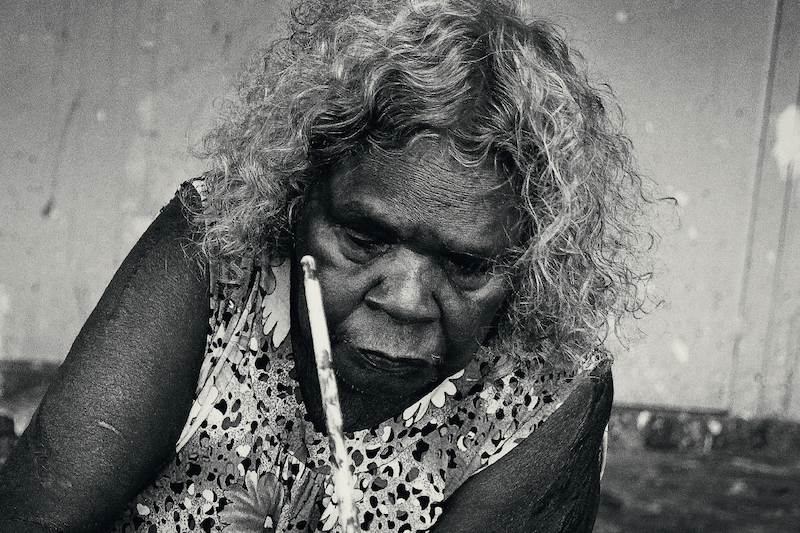Noŋgirrŋa Marawili: Fingers in the paint
The work of Nonggirrnga Marawili can at once ground viewers in the present and speak to another time.
Words: Hayley Megan French
Photography: Pep Phelan
If you stand up close to one of Nonggirrnga Marawili’s monumental bark paintings, you will likely see fingerprints in the paint, hairs trapped in the glue, drawing marks not fully erased. Stepping back, your eyes follow the lines mapping each movement of their maker, navigating the undulating surface of the bark. The materiality of the works are striking: sculptural in the way they protrude off the wall, embedded in their locality. When asked by Buku-Larrnggay Mulka coordinator Will Stubbs where is this place she is painting, Marawili replies that it could be anywhere, “my Country, your Country”—it is not what she is painting, but that she paints, that is important.
And yet the outcome of this action is transformative. A composition that at first glance may feel uneasy soon becomes the stand out feature of the work. Marawili’s large voids and bold lines can slow you down, ground you in this moment, this place, while giving you a glimpse of another.
Marawili has developed a distinct and innovative style in the Yolngu painting tradition, divergent from that of her late husband Djutjadjutja Mununggurr with whom she began painting, yet drawing on this history and familial ties. Marawili’s father was Mundukul Marawili, a great warrior ally to Wonggu Munung-gurr—a renowned leader of the Balamumu at Trial Bay. She lived an extraordinary life in the bush, moving about the Blue Mud Bay region with her family consisting of more than 50 close relations. As a senior woman and mother, Marawili has primarily resided in Yirrkala for more than 20 years, participating as a woman of indomitable spirit at ceremony and as an artist with Buku-Larrnggay Mulka.
Since coming to work in the courtyard of the art centre in 2011, Marawili has found space and time to develop her powerful style. Since 2013, she has had four solo exhibitions at Alcaston Gallery, Melbourne, and has participated in significant group shows and fairs in Australia and internationally. Her current works are part of her Yirritja period, which defines the movement away from her husband’s Djapu clan style—the series of works in Marawili’s first solo show And I am still here, 2013. The Yirritja period begins with Marawili’s second solo show Yathikpa in January 2014 and includes the Baratjula period: characterised by a divergence from the strict Madarrpa clan Yathikpa style to looser more undefined abstraction. The diamond shapes in the work refer simultaneously to water and fire. Marawili has said of her work: “And the paintings I do are not sacred. I can’t steal my father’s painting, I just do my own design from the outside. Water. Rock. Rocks which stand strong and the waves which run and crash upon the rocks. The sea spray.”
Marawili’s work dismisses any questions of the contemporaneity of bark painting: these works are challenging in their composition, subversive in their unprecedented rendition of clan designs, and innovative in their expansion of the medium and painterly techniques. Recent works have been painted on Bangarra boards, due to her prolific nature and the lack of availability of barks during the dry season. Marawili enlivens the flat surface by revealing their materiality: leaving her voids unpainted, the timber board confidently showing through.
When we do slow down, dwarfed as we are by Marawili’s works, we experience an interruption to our own rhythm. The rhythm of Marawili’s life—history, memories; the way the water crashes against the rocks at high tide, and the barnacles left on the rock as the waves recede—can be felt through her action of painting. We can experience here Jacques Rancière’s statement of the contemporary: “There are several times in one time.” Marawili’s work embodies this defining notion—what was happening then, is happening now; and will happen—which is why it is imperative to a wide audience and painting discourse, both in Australia and beyond.
This article was originally published in Art Collector issue 80, April-June 2017









